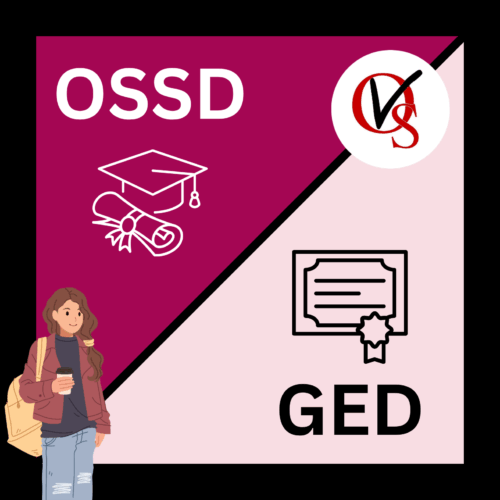
If you are no longer attending a regular high school, but you have not graduated yet, you may be trying to figure out what your next move is for your education. You may be considering college, university, or a trade, and wonder which is the best option to help you get to where you need to go: the OSSD or a GED. What exactly is the difference? And which one is needed for certain post-secondary pathways?
What is the Ontario Secondary School Diploma (OSSD)?
The OSSD – Ontario Secondary School Diploma – is what you earn after completing high school in Ontario. It has a list of requirements that include a total of 30 credits, 40 volunteer hours, and a passing score on the Ontario Secondary School Literacy Test (OSSLT). This typically takes students four years to complete, although it can take longer for some, or can be completed in less time with OVS.
What is the General Education Development (GED) Test?
The General Educational Development (GED) – now renamed the Canadian Adult Education Credential (CAEC) – is a test adults can take to earn an Ontario High School Equivalency Certificate. Essentially, this tells employers and colleges that you have similar knowledge to what high school graduates have.
Students will write the test over approximately 7.5 hours, covering 5 sections: reading (50 questions), writing (1 persuasive writing task), mathematics (42 questions), science (35 questions), and social studies (40 questions). The test costs $100 to write all five sections and students must receive at least 55% in each section to pass. The CAEC (previously GED) can be written through The Independent Learning Centre.

Which is Right for Me?
While the GED/CAEC may be appealing because it’s fast and inexpensive, it can be limiting in what you can do with it. If you plan to attend university or college, you will likely be required to earn the OSSD. Many university programs have specific requirements, like certain credits or grade averages that must be earned. In these cases, the GED/CAEC will not be sufficient. Some post-secondary schools may accept a GED/CAEC as long as the student also earns a certain grade in a specific class. Trade schools, the military, or jobs that require no post-secondary education are more likely to accept a GED/CAEC. Certain colleges, such as Fanshawe College, also offer pathway programs that lead GED/CAEC students to university; however, this can be 1-2 years of post-secondary schooling, in addition to university.
The OSSD offers many more options for careers and post-secondary institutions, so many people consider it to be worth the time investment. Earning the OSSD means you are more likely to be accepted into college or university, and to gain employment from jobs that offer higher than minimum wages. Most university/college programs have a list of requirements, including certain classes with a minimum grade. For example, the nursing program at Trent University requires prospective students to have a minimum of 70% in ENG4U, SBI4U, SCH4U, and any 4U math, such as MHF4U.
Conclusion
Ontario Virtual School offers many different courses that allow students to earn their OSSD entirely online, if that is what best suits them. An OSSD from OVS is the same as one from other Ontario high schools, meaning OVS is fully-accredited, and graduating students have a high acceptance rate into post-secondary institutions. OVS offers similar flexibility that a GED/CAEC does, and can help you achieve your post-secondary goals.
Written by Michelle Miller (OVS Teacher)
